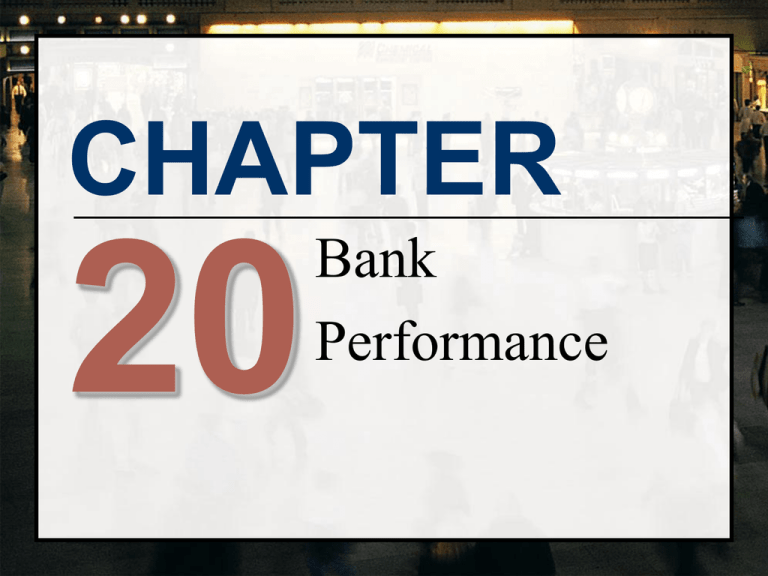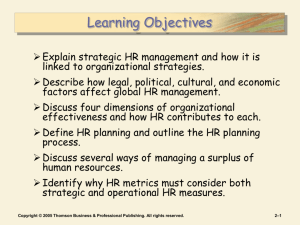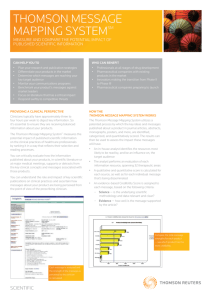
CHAPTER
20
Bank
Performance
Performance Evaluation of Banks
OUTLINE OF INCOME STATEMENT
Interest Income (from loans & investments)
- Interest Expense
= Net Interest Income (spread or margin)
+ Non-interest Income
- Non-interest Expense
- Loan Losses (Bad Debt Expense)
+/- Security Gains/Losses
- Income Tax
= Net Income
Copyright© 2002 Thomson Publishing. All rights reserved.
Exhibit 20.2
Copyright© 2002 Thomson Publishing. All rights reserved.
Ch 20, Problem (10e, p. 529; 11e, p.563)
Managing in Financial Markets
INCOME STATEMENT FOR HAWAII BANK
% of Avg Assets
Interest Income (from loans & invest.)
?%
- Interest Expense
?%
= Net Interest Income (spread or margin)
?%
+ Non-interest Income
?%
- Non-interest Expense
?%
- Loan Losses (Bad Debt Expense)
?%
= Net Income before Tax
?%
- Income Tax
?%
= Net Income
?%
ROA = (Net Inc / Avg Assets) = ?%
ROE = (Net Inc / Equity)
?% /
?% =
?%
or ROE = ROA * (Avg Assets/Equity) = ?%
Copyright© 2002 Thomson Publishing. All rights reserved.
Performance Evaluation of Banks
Interest income and expenses
Gross interest income = interest income generated from all
interest-bearing assets
Gross interest expenses = interest paid on deposits and
borrowed funds
Affected by market rates
Impacted by composition of bank assets (loans provide higher
rate than liquid investments)
Affected by market rates
Impacted by the composition of bank liabilities (demand
accounts are less costly than time deposits)
Net interest income = gross interest income –
interest expenses
Copyright© 2002 Thomson Publishing. All rights reserved.
Gross Interest Income/Expense
Copyright© 2002 Thomson Publishing. All rights reserved.
Copyright© 2002 Thomson Publishing. All rights reserved.
Performance Evaluation of Banks
Noninterest income and expenses
Noninterest income results from fees charged on
services
Lockboxes, overdraft fees, ATM fees, banker’s acceptances
fees, cashier check fees, foreign exchange transactions,
investment banking and other advisory fees
Loan loss provision is a reserve account established in
anticipation of future losses
Noninterest expenses include salaries, office
equipment
Securities gains and losses
Copyright© 2002 Thomson Publishing. All rights reserved.
Copyright© 2002 Thomson Publishing. All rights reserved.
Copyright© 2002 Thomson Publishing. All rights reserved.
Performance Evaluation of Banks
Return on assets (ROA)
Net income as a percent of total assets
Net Income / Total Assets = ROA
Usually lower for large banks (money center banks)
because they obtain funds from large deposits (CDs)
that pay higher interest rates. Small banks usually get
funds from demand deposits (zero interest) and small
savings accounts (low interest).
Copyright© 2002 Thomson Publishing. All rights reserved.
How to Evaluate a Bank’s Performance
Examination of Return on Assets (ROA)
Will usually reveal poor performance, but will
not indicate the source of the problem
Possible reasons for a low ROA:
Excessive interest expenses (e.g too many CDs)
Low interest received on loans and securities
Insufficient noninterest income
Too conservative with loans—excessive short-term securities
Service fees too low (should raise NSF fees, etc.)
High provision for loans losses
Copyright© 2002 Thomson Publishing. All rights reserved.
Performance Evaluation of Banks
Return on equity (ROE)
The return on capital invested
Net Income / Capital = ROE
ROE = ROA x leverage multiplier (inverse of
capital ratio)
ROE for large banks has been lower than for small
banks for the same reasons that their ROA has been
lower
Copyright© 2002 Thomson Publishing. All rights reserved.
Copyright© 2002 Thomson Publishing. All rights reserved.
Exhibit 20.11 Breakdown of Performance Measures
Copyright© 2002 Thomson Publishing. All rights reserved.
Influence of Bank Policies and Other Factors on a
Bank’s Income Statement
Copyright© 2002 Thomson Publishing. All rights reserved.
Zager Bank Example
Application:
Example of Zager Bank
Zager bank is a medium size bank
Aggressive management style can be viewed as risky due to
limited collateral and cash flow situation.
The bank charges high interest rates on loans because the
borrowers do not have alternative lenders.
Strategy was successful during strong economic conditions.
When economy weakened in 2008, borrowers had trouble
repaying their loans.
Copyright© 2002 Thomson Publishing. All rights reserved.
Zager Bank Example
Copyright© 2002 Thomson Publishing. All rights reserved.
Risk Evaluation of Banks
No consensus measurement exists that would
allow for comparison of various types of risk
among all banks
Some analysts measure a firm’s risk by its
beta, which measures the sensitivity of stock
returns to the market as a whole, but
Beta ignores firm-specific characteristics
Examples: look up BofA (BAC) or Banner
Bank (BANR).
Copyright© 2002 Thomson Publishing. All rights reserved.
Beta measures non-diversifiable risk
Copyright© 2002 Thomson Publishing. All rights reserved.
Betas During Financial Crisis
Feb-08 / Today
0.19 / ? (BAC - Bank of America)
1.14 / ? (C - Citibank)
0.5 / ? (JPM - JP Morgan Chase)
0.04 / ? (WFC - Wells Fargo)
1.17 / ? (BANR - Banner Bank)
Copyright© 2002 Thomson Publishing. All rights reserved.
History of U.S. Bank Failures
# of banks failed
3 in 2007
30 in 2008
148 in 2009
157 in 2010
92 in 2011
51 in 2012
24 in 2013
18 in 2014
7 in 2015
2 so far in 2016
See FDIC website for details http://www.fdic.gov/bank/individual/failed/banklist.html
Copyright© 2002 Thomson Publishing. All rights reserved.
Bank Failures
Historical reasons for bank failure
Fraud from poor internal controls
High loan default percentage
Excessive reliance on a specific industry (such as oil, defense, or
agriculture) or a specific geographic location.
Recession periods
Liquidity crisis
Embezzlement of funds
No separation of personnel duties—esp. at small banks
Bank runs, panics
Loss of confidence of financial markets
Increased competition (very tight margins)
Under-capitalization / over-leverage (too much debt)
Copyright© 2002 Thomson Publishing. All rights reserved.
Bank Failures
Study by the Office of the Comptroller of the Currency
reviewed 162 national banks that have failed since
1979 and found that:
81% did not have a loan policy or did not closely follow their
policy
59 % did not use an adequate system to identify problem loans
63% did not adequately monitor key bank officers or departments
57% allowed one individual to make major corporate decisions
Since these are all controllable, must conclude major reason
is poor management.
Copyright© 2002 Thomson Publishing. All rights reserved.





